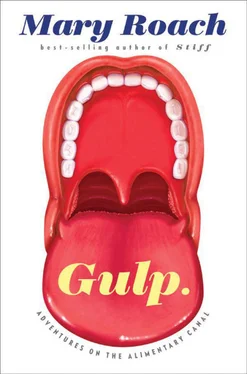Most suicide bombers don’t achieve their goals via the explosives themselves. It’s shrapnel that kills people. The typical marketplace suicide bomb is packed with nails and ball bearings—things you can’t get past the airport metal detectors. To make a bomb that could bring down a plane, you’d need something that is, ounce for ounce, more explosive than TNT or C-4. Generally speaking, the more explosive the material, the more unstable it is. Trip and fall, or cough in the security line with a stomach full of TATP, and you may explode prematurely.
Materials found at Osama bin Laden’s compound in Pakistan are said to have included a plan for surgically implanting a bomb in a terrorist’s body—“in the love handles,” according to an unnamed U.S. government source quoted on the Daily Beast . (Breast implants have also been tossed around as a possibility.) Crump has heard credible rumors of Al Qaeda physicians having tried out body implantation on animals. “But here again,” Crump said, “there are a lot of issues. How to detonate it. How to keep the body from absorbing most of the blast.” How to protect the explosives and the detonator from moisture.
This was comforting, but only for a moment. “Really, why bother with all that?” Crump said. “With a bit of prior observation, I can generally figure out a way to avoid going through a body scanner at most international airports.”
THE PREFERENCE IN California prisons for rectal smuggling is a little surprising given the preponderance of Latinos and African Americans—two populations that are, taken as a whole, somewhat less comfortable with homosexuality. Prison, I’m guessing, is a place where extenuating circumstances erode the stigma that otherwise attaches to extracurricular uses of the rectum.
Rodriguez speaks freely about the situation in Avenal. Rather than antagonize gay inmates, he says, gang leaders tend to employ them. “We call them ‘vaults.’ If they’re reliable, the homies will approach them—‘Hey, check it out, you want to make some money?’”
Everyone else has to practice to get up to speed. Rodriguez recalls his “cherry” assignment—the blades—as extremely painful. He says gang underlings are made to practice. I picture muscular, tattooed men puttering around the cell with soap bars or salt shakers on board. Lieutenant Parks showed me an 8 × 10 photograph of what he said was a practice item, one that landed the apprentice in Medical Services. Deodorant sticks had been pushed into either end of a cardboard toilet paper tube and wrapped in tape. “As you can see,” he said in his characteristic deadpan, “it’s a rather large piece.” (Rodriguez says it was hooped on a bet.)
“To avoid anal laceration, dilation may have to be performed progressively over a period of several weeks or months.” This quote comes from a journal, but it is not a corrections industry journal or even an emergency medicine or proctology journal. It’s from the Journal of Homosexuality. A corrections or even a proctology journal would not have gone on, in the very next sentence, to say, “Rowan and Gillette (1978) have described the case of a man who derived sexual pleasure from inflating his rectum with a bicycle tire pump.” (As I did not pursue the reference, I remain ignorant of this man’s fate and whether he exceeded the recommended PSI of the human rectum.)
Air and water (in the form of enemas) are the safest route to recreational distention because of the dependable ease of their removal. (An exception must be made for liquids that harden into solids. See “Rectal Impaction following Enema with Concrete Mix.”) Solid objects tend to “get away from you,” says gastroenterologist Mike Jones. “There’s lubricant on the object, on the hands, you’re in the throes of excitement and you’re trying to grab it, and it’s like, gone .” The ensuing panic makes it worse. Recall that anxiety causes clenching.
In the words of Anna Dhody, the ghoulishly ebullient Mütter Museum curator, “Every hospital has an ass box.” The emergency medical literature is rife with case reports full of nouns you don’t expect to see in a journal: oil can, parsnip, cattle horn, umbrella handle. The verb of choice, by the way, is deliver. As in: “This suction must be broken to deliver such glass containers.” “A concrete cast of the rectum was delivered without incident.”
One paper on the subject looked at thirty-five emergency room cases, all of them men. An explanation for the preponderance of males can be found in the aforementioned Journal of Homosexuality paper: “For males, dilation of the rectum… causes increasing pressure on the prostate gland and seminal vesicles, thus producing sensations that may be interpreted as sexual by some individuals.” (The author, or perhaps there are two by the same name, appears to be a man of divergent interests. I found a list of his books on Goodreads.com. Colorado above Treeline , the list begins. Life of a Soldier on the Western Frontier . And then, nestled between Medicine in the Old West and Exploring the Colorado High Country , was The Enema: A Textbook and Reference Manual .)
Any discussion of the sexuality of the digestive tract must inevitably touch on the anus. Anal tissue is among the most densely enervated on the human body. It has to be. It requires a lot of information to do its job. The anus has to be able to tell what’s knocking at its door: Is it solid, liquid, or gas? And then selectively release either all of it or one part of it. The consequences of a misread are dire. As Mike Jones put it, “You don’t want to choose poorly.” People who understand anatomy are often cowed by the feats of the lowly anus. “Think of it,” said Robert Rosenbluth, a physician whose acquaintance I made at the start of this book. “No engineer could design something as multifunctional and fine-tuned as an anus. To call someone an asshole is really bragging him up.”
The point I had been making is that nerve-rich tissue, regardless of its day-to-day function, tends to be an erogenous zone. Is it possible that these people who wind up in the emergency room are just folks whose anal play toys escaped into the interior?
Some, perhaps, but not all. Anal sensitivity cannot explain the man with the lemon and the cold cream jar. It cannot explain 402 stones. It cannot explain brachioproctic eroticism. [78] A term coined by sexologist Thomas Lowry. In his efforts to research fisting, Lowry found himself writing letters to strangers at academic institutions that would begin like this: “Dear Dr. Brender: We spoke on the phone several months ago about ‘fist-fucking.’ At that time you mentioned two surgical articles.” There was no academic term, so eventually Lowry made one up. “I Googled it recently,” he told me, “and found over 2,000 hits. Made me chuckle.”
Research done by sexologist Thomas Lowry in the 1980s confirms the existence of a separate and devoted group of people whose specific joy derives from the sensation of stretching or filling. Lowry sent me a copy of his paper and the questionnaire he’d used to gather his data. Item 12 was a drawing of an arm, with the instructions, “Indicate with a line the deepest you have been penetrated.” Suffice it to say that the anus, exquisitely sensitive though it may be, does not lie at the heart of these people’s passions. Suffice it to say that some people enjoy Exploring the Colorado High Country.
Gustav Simon was the doctor for them. In 1873, Simon pioneered [79] Simon refined his technique on cadavers, rupturing a bowel or two along the way, and then began offering training seminars. Cadavers were replaced with live, chloroformed women, thighs flexed on their abdomens. “A large number of professors and physicians” flew all the way to Heidelberg to practice “the forcible entrance.”
the “high introduction” of a whole hand, “richly oiled,” into the rectum. This was done with the other hand pressed to the abdomen, to palpate the pelvic organs and check for abnormalities. (Gynecologists employ the method today, though typically hold themselves to two fingers.) Any resulting “pain in the parts,” Simon assured the reader, was fleeting.
Читать дальше












